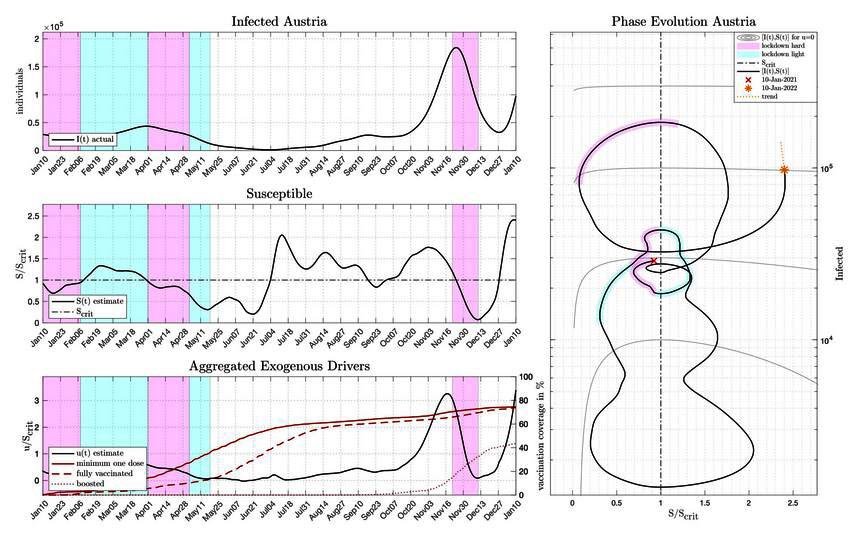
New COVID Epidemometer Offers Precise Epidemic Predictions

Diagram top left: Course of active case numbers. Diagram middle left: Susceptible proportion of population. Diagram bottom left: Aggregated exogenous drivers incl. course of vaccination rates.
(c) TU Wien
Young research team publishes new method for accurate prediction of epidemic dynamics. Country comparisons included.
The COVID-19 pandemic still poses major challenges in crisis management to governments and health systems. Epidemiologic models play a critical role in this effort, supporting policymakers by predicting future infection progression and hospitalization rates. A key challenge here is to determine non-measurable epidemiological states such as susceptibility to infection in real time.
Young researchers at TU Wien have now published a new method that can be used to easily and robustly predict the susceptibility of the population to infection as a result of a viral mutation based solely on officially available data. The course of a pandemic is determined by so-called exogenous drivers. These are, for example, the changing social behavior of the population, mobility or lockdowns. In most cases, however, the effects of these factors are unknown and therefore seriously complicate the analysis and prediction of the highly dynamic infection event. With the new method, these exogenous drivers can also be determined easily and in real time. As a result, quantitative effects of lockdowns, for example, can also be predicted.
“Epidemometer”
More accurate epidemiological state estimation combined with the determination of the unknown exogenous drivers also enables much more reliable forecasting. With its recent work published in the Journal of Nonlinear Dynamics, the team shows how the method from nonlinear control theory can be applied to common epidemiological compartment models, allowing accurate forecasts of essential quantities such as incidence or hospital occupancy. The research team sees the new “tool” as a scientific support for decision makers and colleagues.
Innovative: control theory + medicine
The new approach was developed by a team led by Prof. Stefan Jakubek at the Institute of Mechanics and Mechatronics at TU Wien in cooperation with researchers at MedUni Vienna. The work of two students at TU Wien, Johanna Bartlechner and Oliver Ecker, played a key role. They provide with a completely new approach – from the perspective of control and process automation combined with medical expertise. They use the method for quantitative real-time analysis and prediction of important variables in the pandemic, specifically hospital and intensive care unit occupancy.
Precise: This method reveals more
A look at the pandemic’s past proves its reliability: “We evaluated our methods using data from different countries over the past few months, and the accuracy achieved significantly exceeded our expectations,” explains student Johanna Bartlechner. As part of the team at TU Wien, she analyzed not only Austria but also other countries such as South Africa, Denmark, Switzerland and the United Kingdom. “Many factors that significantly influence the number of cases or occupancy of intensive care beds are difficult or impossible to quantify and are characterized by strongly nonlinear dynamics,” her colleague Oliver Ecker emphasizes. For example, what the methodology reveals additionally and in real time: How does a new viral variant change the probability of a hospital stay? How effective are government interventions such as lockdowns?
Website: Weekly Update COVID-19 Analytics
The research team at TU Wien shows weekly updated analyses and forecasts for Austria as well as analyses of other countries on its website: https://www.imm-covid-analytics.com, opens an external URL in a new window
Publications
- December 2021: C. Hametner, L. Böhler, M. Kozek, J. Bartlechner, O. Ecker, Z.P. Du, R. Kölbl, M. Bergmann, T. Bachleitner-Hofmann, S. Jakubek
Intensive care unit occupancy predictions in the COVID-19 pandemic based on age-structured modelling and differential flatness
Journal of Nonlinear Dynamics, accepted for publication - September 2021: C. Hametner, M. Kozek, L. Böhler, A. Wasserburger, Z.P. Du, R. Kölbl, M. Bergmann, T. Bachleitner-Hofmann, S. Jakubek
Estimation of exogenous drivers to predict COVID-19 pandemic using a method from nonlinear control theory.
Nonlinear Dynamics 106, 1111–1125 (2021)
Contact
TU Wien | Technische Universität Wien
Institute of Mechanics and Mechatronics
Univ.Prof. Dipl.-Ing. Dr. Stefan Jakubek
Getreidemarkt 9, 1060 Vienna
T: +43 1 58801 – 325 510
stefan.jakubek@tuwien.ac.at
Technische Universität Wien
Büro der Rektorin | Pressesprecherin | Public Affairs
T: +43 1 58801 41025
M: +43 664 484 50 28
Resselgasse 3/Stiege 2
1040 Wien












